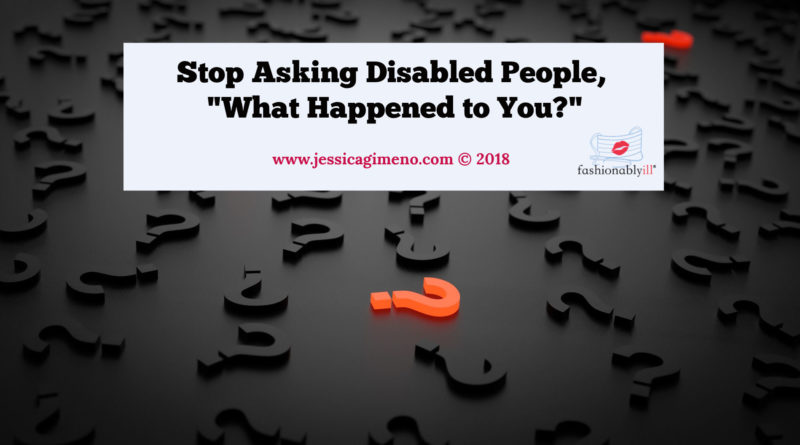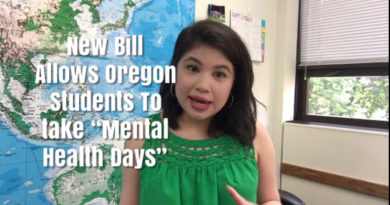Stop Asking Disabled People, “What Happened To You?”
“What happened to you?” “Were you born like this or did something happen to you?” “Why are you in a wheelchair?” “Why do you use a cane?” Or my personal favorite, “What’s wrong with you?” If I had a dime for every time a stranger asked me this question the past eight years, I’d be a wealthy woman. I use a cane everyday. The above are just are just a sample of the questions people with disabilities, visible skin conditions, and other differences are frequently asked. Disability advocates that I work with who are little people share stories of strangers filming them. Imagine taking the subway to work and having a mom and her two children laugh at you while she films you on her iPhone!
Living In An Inaccessible World
Disabled people are people. Just like you. We have kids to pick up from school, errands to run, jobs to get to, and meetings to attend. And we have to get there on time. We face obstacles from ableism including institutional discrimination. Like going to a store that has no disability entrance. Getting to work only to find that the elevator is not working. Going to school only to find someone has parked in front of the disability entrance. And being invited to a friend’s party at a restaurant with no elevator even though the restaurant is on the third floor. Or dealing with inaccessible public transportation. Every time I use the train, I hope the conductors will remember to take out the disability ramp. Even though they promise to do so when I ask, they forget 10% of the time. I have a neuromuscular illness that causes me to randomly lose feeling in my arms and legs. I have to pray that an episode of not being able to feel my legs and/or arms does not coincide with that 10% of the time that they “forget” especially if I am traveling alone. And, yes, I have had two scary experiences on the train–one time, I was dangling from the train and I was saved by two passengers who sprang into action. Another time, my college-aged nephew, who happened to be visiting, was riding with me.
(Yes, the Americans With Disabilities Act, exists. And the ADA has changed lives for the better. But many civil rights are still ignored twenty-eight years after the ADA was signed into law and many of them are currently under attack including our rights to accessible buildings, to name one example.)
Don’t Be That Person
You may think your question is innocuous but do you realize you are the ninth person to ask that question this week, maybe even today? Imagine waking up tired everyday and living with 24/7 pain.* You have to choose between eating lunch or taking a shower because of limited energy. Then, imagine trying to get somewhere knowing it might take you twice as long as your able-bodied peers and that you will be bombarded by strangers asking, “What happened to you?” Now, do this every time you leave the house.
Disabled people are not museum exhibits. We don’t owe strangers and curious people our time and energy. For all the times we explain why we look this way or why we are using mobility aides, we are not being paid for our time. I have one friend who says that she likes it when people ask her, “What’s wrong with you?” because she views it as a teachable moment. But I ain’t Oprah.
If you are tempted to ask a question that starts with, “This may be inappropriate to ask but,” don’t do it. Disabled people are not Marvel comics characters; they don’t owe you their origins stories. If you are asking questions, is your motivation satiating your curiosity or a genuine desire to help? People who want to help do not come off as intrusive. It’s one thing to hold open a heavy door for a disabled person who is struggling to get inside the building because the disability entrance is broken or because there is no disability entrance. It is another thing to ask a stranger in line at McDonald’s, “Can I lay hands over you?” and start praying over them. This is a thing that frequently happens to people who use wheelchairs.
How To Be An Ally
Disabled people often deal with places that are “up to code but not accessible” like buildings whose disability ramps are hidden at the back of the building. Finding the disability entrance should never feel like an Easter egg hunt. I once spoke at a mental health conference where the stairs, which led directly to the conference room, were at the front of the building. However, the disability ramp was at the far end of the building. So while other speakers would walk directly to the conference room, I had to make a 6-minute detour every time to use the ramp, which led to the elevator, and then finally the conference room. Even though I usually arrived on time to sessions, I looked tardy because all the other speakers were already seated. This is what it’s like to be disabled in a society that treats accessibility as an after thought. Halfway through the conference, one of the other speakers noticed my predicament and said it wasn’t fair that the ramp was so far away. She started taking the ramp with me. The other able-bodied speakers joined us. I was no longer walking into each session later than everyone else. This is allyship. My colleague did not pepper me with questions (Why do you carry a cane?, How long do you have to live?, What happened…?). She just put herself in my shoes.
If you truly want to help disabled people, learn about our civil rights. Help us tear down institutional barriers so that we can have equality in housing, transportation, healthcare, marriage, education, and employment. Follow voices like Gregory Mansfield, Alice Wong, Erin Gilmer, Matthew Cortland and ADAPT, a national grassroots disability organization that fights institutional bias. Follow the hashtag #CripTheVote on Twitter.
*Caveat: Not everyone who has a disability lives with chronic pain and fatigue just as not all disabilities are visible. I just happen to live with myasthenia gravis, endometriosis, daily otitis media, psoriasis, and other conditions I’m still learning how to pronounce.



